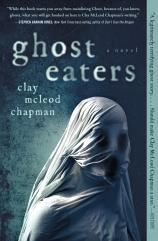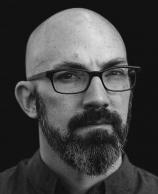Author Talk: July 12, 2023
One of Vulture's Best Horror Novels of 2022 and now available in paperback, GHOST EATERS is a terrifying supernatural page-turner that will make you think twice about opening doors to the unknown. In this interview conducted by Quirk Books, Clay McLeod Chapman explains where the idea for Ghost, a drug that allows users to see the dead, originated. He also offers his thoughts on why the menacing nature of horror lends itself well to themes of grief, memory and addiction; talks about why he set GHOST EATERS in Richmond, Virginia; details his writing and research processes; and reveals his horror inspirations for this book.
Quirk Books: In this novel, Ghost is a pill that brings new meaning to the phrase “I see dead people.” Where did the idea for a drug that allows people to “get haunted” originate?
Clay McLeod Chapman: It was the intersection of three things over the course of a few years.
I remember reading stories back in 2013 about krokodil, a deadly designer drug that essentially devours its users. It quickly became known as “the flesh-eating drug” because of how it ravaged users’ bodies. These reports were absolutely horrendous, but they led me to think about the undertow of addiction, how quickly people can get sucked in and completely lose themselves --- their identity, their autonomy, their lives. Loved ones are suddenly no longer themselves. Nothing felt more genuinely horrifying than that.
Later, like in 2015 or so, I was developing a feature project for a film company, in which the core concept stemmed from the basic premise of a haunted drug. You pop a pill, you see the dead. It was a little too Freddy Krueger-y. A demon-like entity targets stereotypical teens who used this new street drug that allowed them to see the dead. The project fizzled, but the idea lingered in the back of my mind.
Finally --- and this is a little too close to the bone for me, but --- I lost someone to their addiction. I wasn’t there for them when they needed a friend, and I’ve never forgiven myself for that. It was the convergence of these elements that led to the notion of the haunted drug Ghost and how it affects its users.
QB: What was the genesis of the idea of mushrooms that could create a drug-induced séance?
CMC: When I first started configuring the drug Ghost, I went through the various methods we ingest narcotics and asked what the best mode of delivery for this fictional hallucinogenic was. Is it a powder we snort? Is it a manufactured chemical like LSD? Is it a pill or a tab? Morbid as it may sound, I’ve always been fascinated by the cyclical nature of life and death. Our bodies return to the earth and feed new life, whether that’s food for worms or new vegetation. Which got me to thinking: What if this drug was a part of that cycle? What if the drug itself was cultivated and grown through the bodies of its own users?
And it must be said that there is a wondrously lush lineage of fungal horror that I hoped to tap into: “The Voice in the Night” by William Hope Hodgson, FRUITING BODIES AND OTHER FUNGI by Brian Lumley, and MEXICAN GOTHIC by Silvia Moreno-Garcia, just to name a few. It’s such a lovely niche to lose yourself in.
The drug-induced séances were some of the most exciting scenes for me to write. I’m obsessed with the Fox sisters. Ever since I first watched Peter Medak’s The Changeling from 1980, I’ve been absolutely determined to write a séance scene. Multiple séance scenes, but I wanted to write something different. It couldn’t just be a group of twentysomethings with a Ouija board. We’ve seen that. I started thinking of the books that gave the supernatural a different kind of spin, taking the tropes and recalibrating them: THE HOUSE NEXT DOOR by Anne Rivers Siddons. HOUSE OF LEAVES by Mark Z. Danielewski. Then I started thinking about supernatural procedurals --- books or films where there is a group of scientists or specialists attempting to rationalize the paranormal: ALTERED STATES by Paddy Chayefsky. SUPERSTITION by David Ambrose. “From Beyond” by H. P. Lovecraft. And don’t forget Flatliners!
QB: GHOST EATERS puts grief, memory and addiction --- themes that are typically explored in memoirs and literary fiction --- at the center of a horror novel. Why do you think that the menacing nature of horror lends itself well to these themes?
CMC: There was a fundamental question I asked myself over and over again when I was writing this: What is it like to be haunted? In ghost stories, we speak of haunted houses --- a physical location that has been imbued with the trauma of loss, the death of someone, whose spirit now inhabits this home. We always talk of receptacles when it comes to hauntings. Even beyond houses, there are haunted dolls, haunted boats, haunted mirrors, you name it. But what about people? What if we’re haunted by the ghosts of those we’ve lost? To me, the nature of grief is in and of itself a haunting. Sometimes we can’t let go.
Horror is a perfect platform to explore deeper themes like addiction and grief. The metaphor of monsters is something like a Halloween mask. We layer our emotions beneath the veneer of something supernatural. But for me, it goes a little farther than that. Horror pushes boundaries. Horror is operatic. It allows me to write BIG EMOTIONS and offers me --- and hopefully the reader --- catharsis in releasing these feelings.
QB: Throughout the book, Erin alludes to a belief that “you can’t outrun what haunts you.” Do you think that your ghosts, in whatever form they may be, will always find you?
CMC: I do. There’s a lot of guilt in this book for me. A lot of remorse and regret. These are my ghosts, and I feel like they’ll forever be with me. This book gave me a chance to reflect on my own personal history and where I failed as a friend…and how I’ve personally worked toward becoming a better person.
On another level, I wanted to write about privilege. I wanted to write about the naiveté of our 20s. What are the consequences of our youthful indiscretions? What happens if we party on someone’s grave?
QB: According to The Lancet, 2020 was the deadliest year in the North American opioid epidemic. With GHOST EATERS, you turn a mirror onto the power of addiction and the stronghold grief has on the US, creating a powerful narrative of a country possessed. How do you think horror novels can help readers explore and come to terms with the darkness of US society?
CMC: The opioid crisis loomed large over the writing of this book. So did my own family’s personal struggles with addiction. Everyone is affected by this in some way, whether it’s alcohol or drugs or both. That addiction is in and of itself a ghost that always follows. It never goes away. You have to learn how to live with your addiction. Live with your demons. People struggling with addiction speak of the monkey on their back, but I can’t help but think of the Thai film Shutter, where it’s truly a ghost on our shoulders.
QB: This is your third book set in the South, in this case Richmond, Virginia. What brings you back to this place in your novels?
CMC: Virginia will always be my home. I can’t escape the South. I don’t want to. When I close my eyes and start imagining a new story, I always return to Virginia. It’s inescapable. It’s where my mind lives.
That said, for GHOST EATERS in particular, as I was cracking open this story with my editors, it became clear to us all that there is a large story being told, hiding within the margins of the story I first pitched --- and that’s the story of what haunts the country at large. The psychic trauma of America, particularly in the South, and how that trauma resonates beyond the choice hauntings of our characters. Once that entered into the narrative fold, the South was no longer a backdrop for this particular story but rather an actual character that needed to live and breathe within the scope of the novel. It’s alive!
QB: Why was it important to highlight the history of this particular area in GHOST EATERS?
CMC: Growing up down South, folks are immersed in history. It’s everywhere. There are brass plaques telling you what happened on that particular patch of ground 200 years ago. There are buildings still standing that speak of their past in bite-sized history lessons hanging from the wall. Then there is the oral tradition, the stories that didn’t make their way into history books, the tales you won’t find on a plaque, being shared one listener at a time. Which is all just to say, for me, as a child, I was intensely aware of the past wherever I stepped in Richmond. Virginia has always felt like a graveyard.
QB: You write comic books for Marvel as well as novels, and you’re working on a screenplay for Amazon. What does your writing process look like? Is it different based on the medium you’re writing for?
CMC: I’ve been extremely fortunate to live an extremely humble existence telling stories in all kinds of mediums. I tend to let the story dictate which medium it wants to be told in. As it stands, I have a whole head full of stories I’m dying to tell. And whenever I get an opportunity to pitch an idea, whether that’s to Marvel or Amazon or Quirk, if they bite, well then, we’re off to the races! That story finds a home.
QB: What did your research process look like for this book?
CMC: Oh, man, I read so much. So many books. So many ghost stories and how to cultivate shrooms and the religious experience of hallucinogens. You name it, I’ve imbibed it all.
But come on now. Are you really really asking me if I, you know, took a ride with Lucy in the sky with diamonds? Chased the white rabbit? Hopped on board Ken Kesey’s bus? I’ll never tell.
QB: What were your horror inspirations for this book?
CMC: In all honesty? Everything. Absolutely everything. For starters: Trainspotting, Junkie, Naked Lunch, Bright Lights, Big City, THE ELECTRIC KOOL-AID ACID TEST, just to name a few. Even Fight Club! A special shout-out to Rachel Harrison’s THE RETURN and her sharp, snappy banter of friends in crisis. Plus PET SEMATARY by the King, Bone Parish by Cullen Bunn, all the fungal fiction, and last but not least, the lovely source of inspiration for the title of our spooky little book, Tennyson’s “The Lotos-eaters”!
QB: What’s next for you?
CMC: Oh, man. So many good things. So many spooky things. I have to keep mum for the moment, but let’s just say: I can’t wait to keep scaring you in the future.



